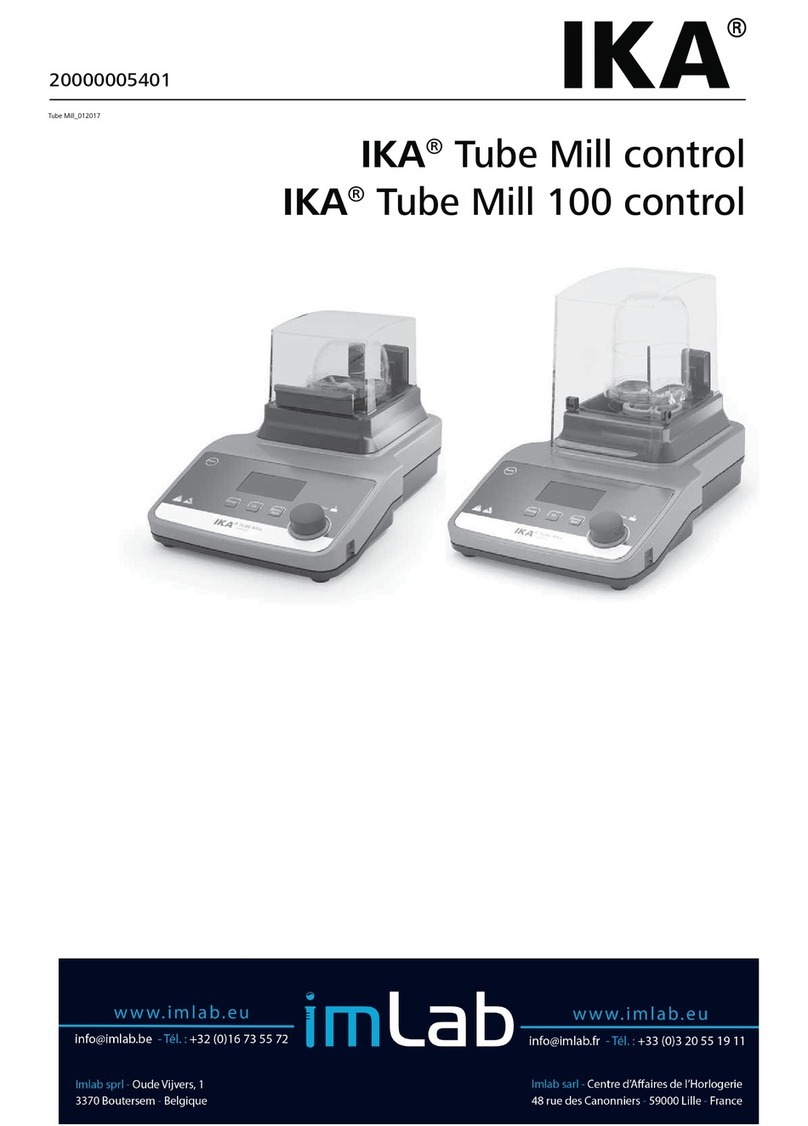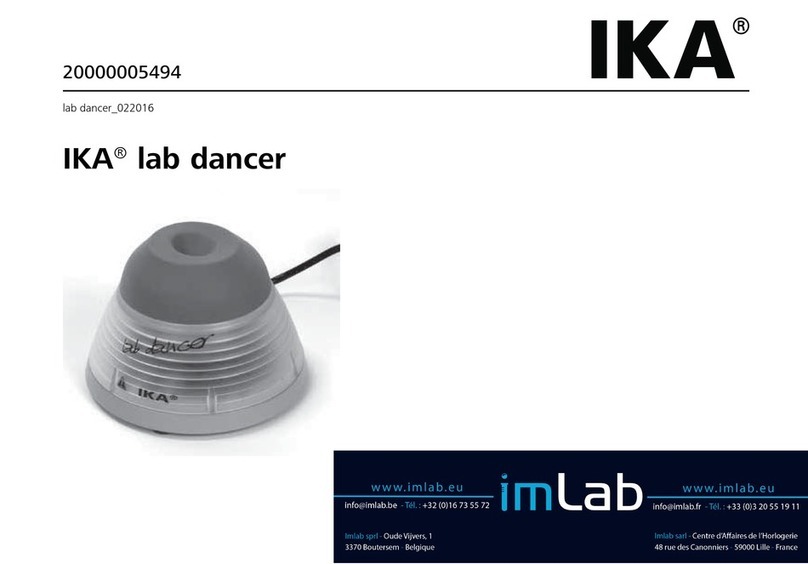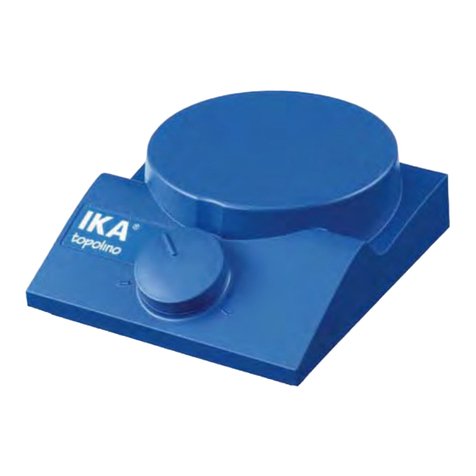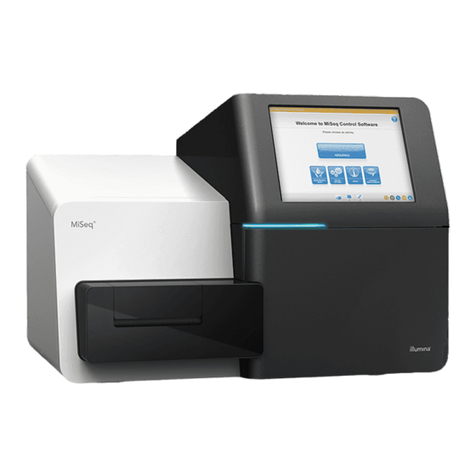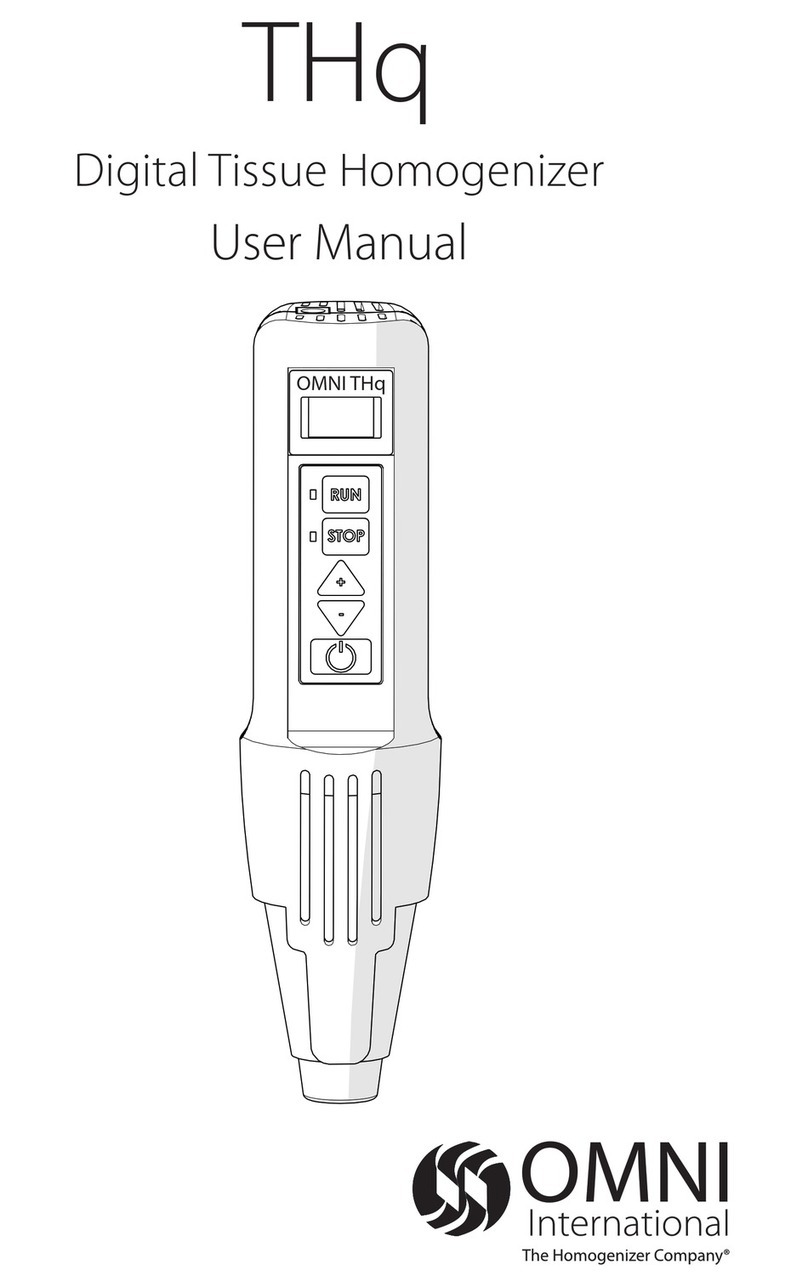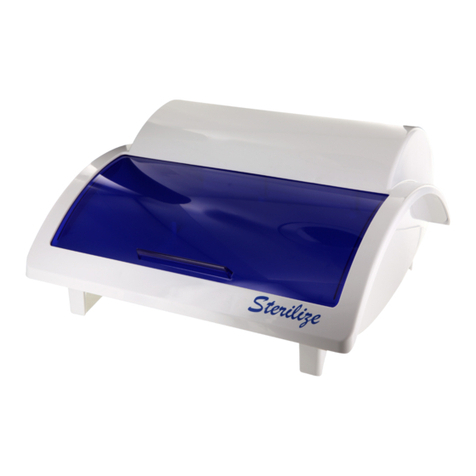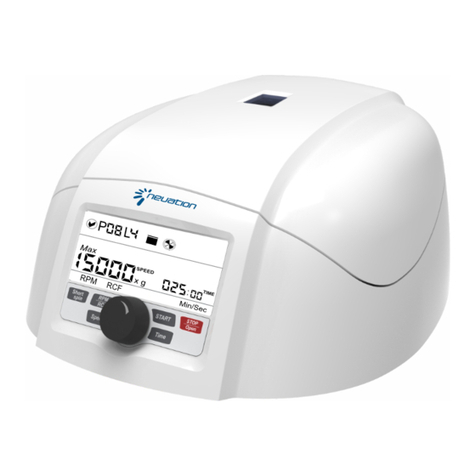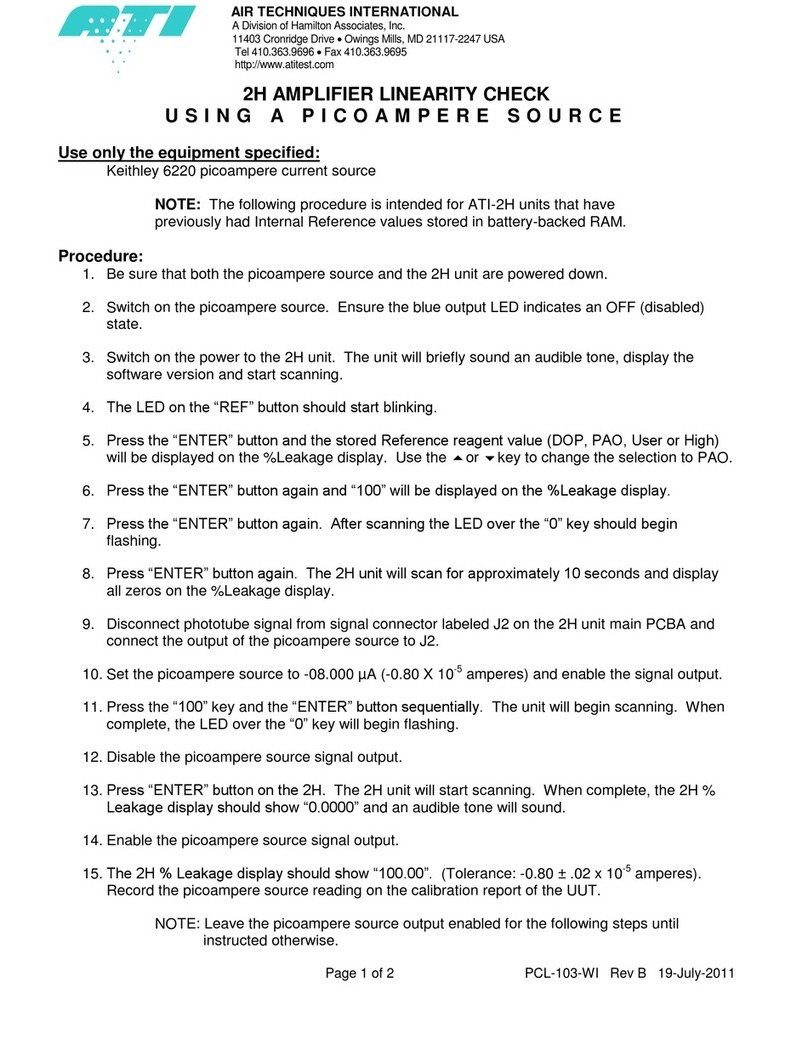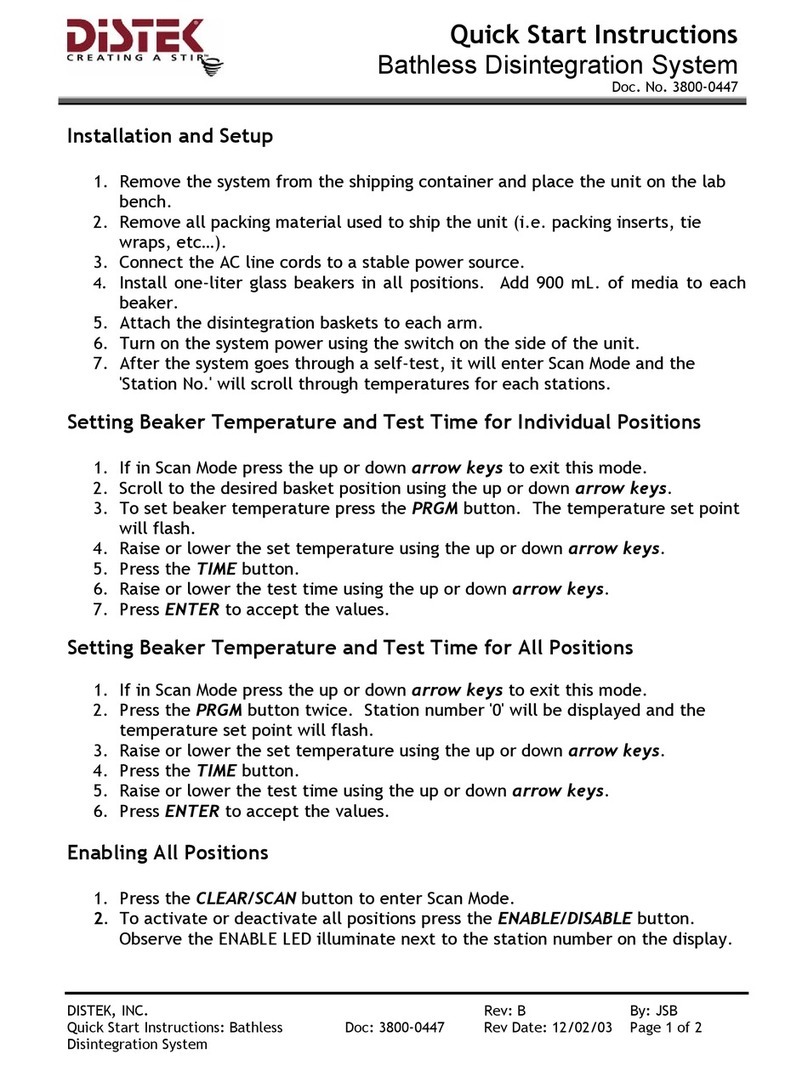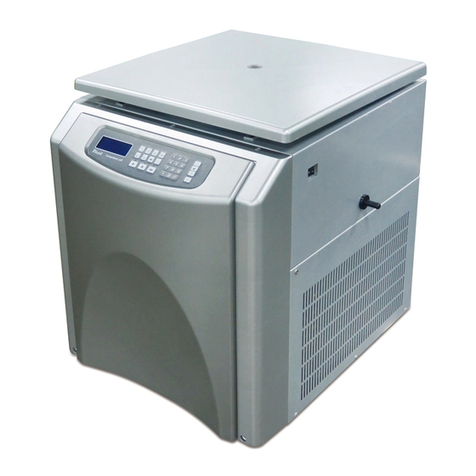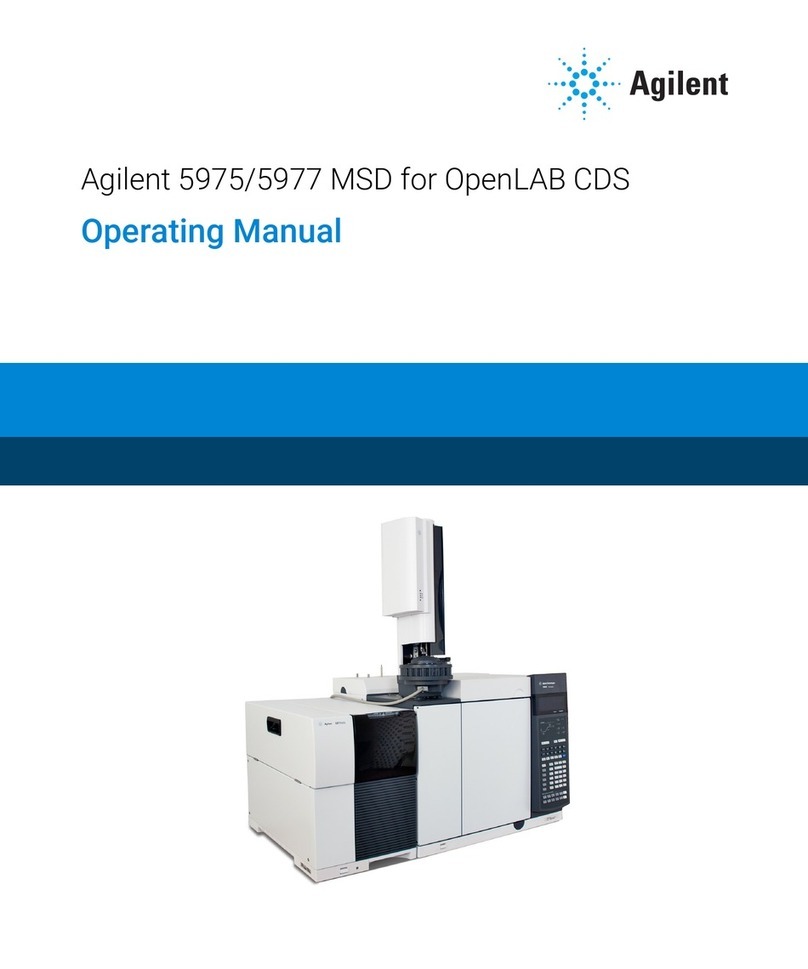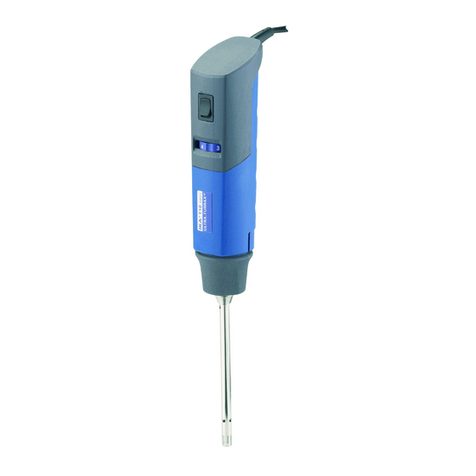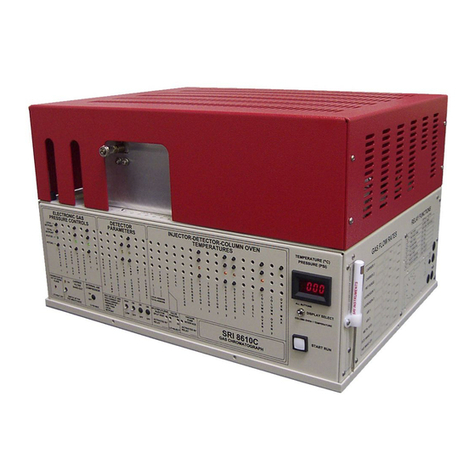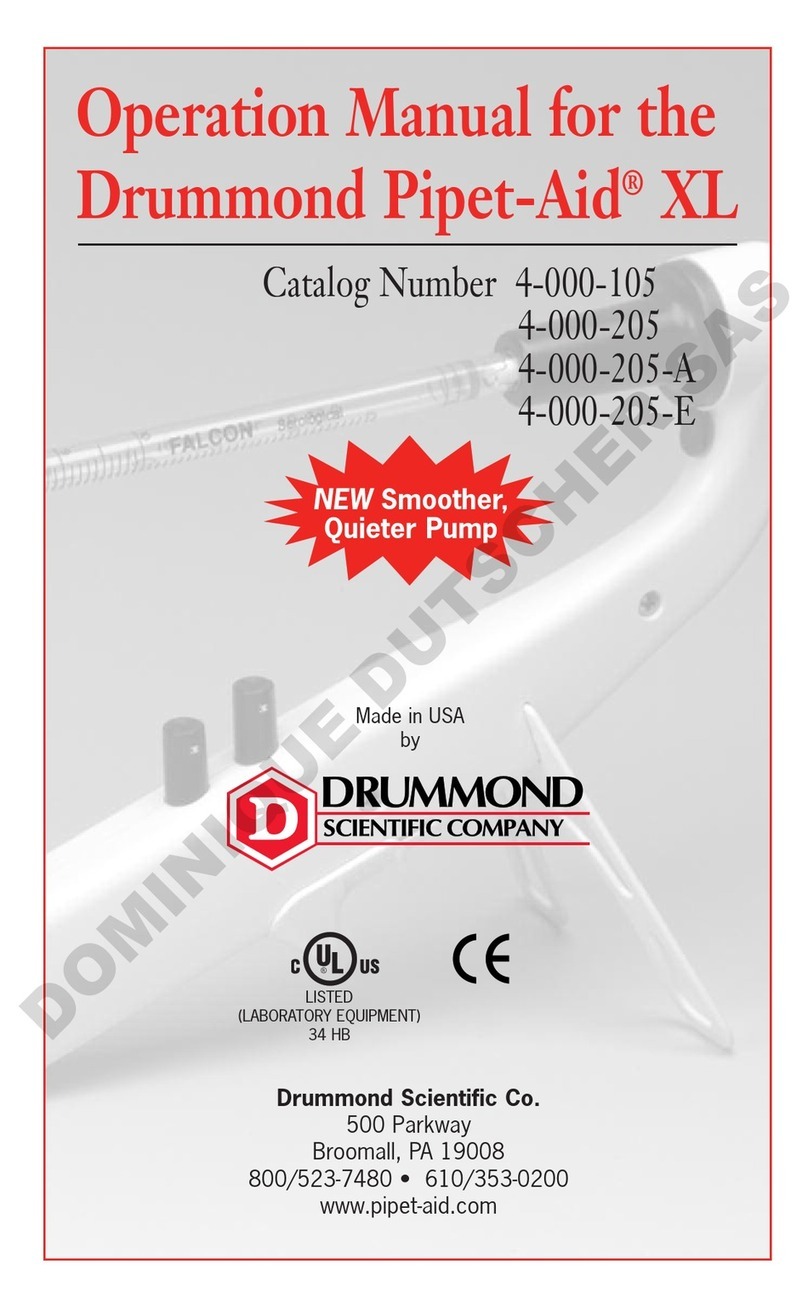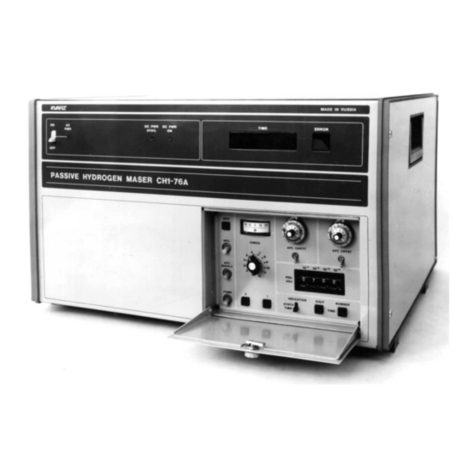Imlab IKA ULTRA-TURRAX T 10 basic User manual

12
T 10 basic_092012
Contents
EN
Page
EC-declaration of conformity 12
Explanation of symbols 12
Safety instructions 13
Correct use 14
Unpacking 14
Useful information 15
Drive unit 15
Assembly of clamp and stand 15
Working with the unit 16
Error correction 16
Maintenance and cleaning 16
Note to the flat key and shaft key 17
Accessories 17
Permitted dispersing tools 17
Speed table 18
Technical data 18
Warranty 19
EC-Declaration of conformity
We declare under our sole responsibility that this product
corrosponds to the regulations 89/336EC, 98/37EC and 2006/95EC
and conforms with the standards or standardized documents DIN
EN IEC 61010-1, DIN EN IEC 61326-1, DIN EN ISO 12100-1, -2 and
EN 60204-1.
Explanation of symbols
General hazard
This symbol identifies information that is of vital
importance for safeguarding your health
and safety. Disregarding this information can
lead to health impairment and injuries.
This symbol identifies information that is of
importance for the technically correct
functioning of the system. Disregarding this
information can result in damage to the instru-
ment or to system components.
This symbol indicates information which is im-
portant for ensuring that the operations of
the appliance are performed eciently and
for using the instrument. Failure to observe
this information can result in inaccurate results.
Source language: German
DANGER
WARNING
ATTENTION

13
T 10 basic_092012
ō
Read the operating instructions in full before starting up
and follow the safety instructions.
ō
Keep the operating instructions in a place where they can be
accessed by everyone.
ō (QVXUHWKDWRQO\WUDLQHGVWDIIZRUNZLWKWKHLQVWUXPHQW
ō )ROORZWKHVDIHW\LQVWUXFWLRQVJXLGHOLQHVRFFXSDWLRQDOKHDOWK
safety and accident prevention regulations.
Wear your personal protective equipment in ac-
cordance with the hazard category of the medi-
um to be processed. Otherwise there is a risk of:
- splashing liquids
- body parts, hair, clothing and jewelry getting
caught.
Please pay attention to the dangerous
points of the equipment marked in Fig. 1.
ō
Check the instrument and accessories beforehand for damage each
time when you use them. Do not use damaged components.
ōDo not operate the instrument in explosive atmospheres, with
hazardous substances or under water.
ō
There may be electrostatic discharges between the medium and
the dispersing instrument shaft which could cause a direct danger.
ō 7KHLQVWUXPHQWLVDOVRVXLWDEOHIRUPDQXDORSHUDWLRQ
ō 6HWXSWKHVWDQGLQDVSDFLRXVDUHDRQDQHYHQVWDEOHFOHDQ
non-slip, dry and fireproof surface.
ō (QVXUHWKDWWKHVWDQGGRHVQRWVWDUWWRPRYH
ō
The agitated vessels used for dispersing have to be secured.
Consider on a good stability of the entire structure.
ō 6HFXUHWKHGLVSHUVLQJYHVVHODJDLQVWWZLVWLQJ
ō *ODVVYHVVHOVPXVWDOZD\VEHVHFXUHGZLWKDFODPSWRSUHYHQW
them spinning. When working with glass vessels, the dispersing
tool must not come into contact with the glass.
ō
Note the operating instructions of the dispersing tool and accessories.
ō 2QO\GLVSHUVLQJHOHPHQWVDSSURYHGE\IKA®can be used.
ō $VVHPEOHH[DFWO\WKHGLVSHUVLRQWRROIROORZLQJWKHLQVWUXFWLRQV
ō 'RQRWXVHWKHLQVWUXPHQWZLWKRXWDGLVSHUVLQJHOHPHQW
ō 8VHWKHGLVSHUVLQJWRRODOZD\VLQVLGHWKHGLVSHUVLQJYHVVHO
ō
Check that the turning handles are secure and tighten if necessary.
ō
Make certain that the unit is set at the lowest speed before com-
missioning; otherwise, the unit will begin running at the set
speed in last operation. Gradually increase the speed.
ō
Reduce the speed if the medium splashes out of the vessel because
the speed is too high.
ō %HIRUHVZLWFKLQJRQWKHGLVSHUVLQJLQVWUXPHQWPDNHVXUHWKDW
its shaft is immersed min. 20 mm in the medium to prevent the
medium from splashing out.
The distance between the dispersing tool and
the vessel bottom should not be less than 10
mm (Fig. 1).
ō
In the event of unbalance or unusual noises, switch off the instru-
ment immediately. Replace the dispersing element. If there is no
difference after the change of the dispersing tool, return it to the
dealer or the manufacturer along with a description of the fault.
Do not touch rotating parts during operation!
ō3lease note that the dispersing element and the journal bearings
may become extremely hot during use.
ō
Only process media that will not react dangerously to the extra en-
ergy produced through processing. This also applies to any extra
energy produced in other ways, e.g. through light irradiation.
ō 'RQRWSURFHVVDQ\ĠDPPDEOHRUFRPEXVWLEOHPDWHULDOV
ō
Process pathogenic materials only in closed vessels under a suit-
able fume hood. Please contact IKA
®
if you have any questions.
ō$EUDVLRQRIWKHGLVSHUVLRQHTXLSPHQWRUWKHURWDWLQJDFFHVVRULHV
may get into the medium you are working on.
Safety instructions
DANGER
DANGER
DANGER
WARNING

14
T 10 basic_092012
Correct use
ōUse
When used in combination with one of our recommended dispersing
elements, the drive unit is a high-speed dispersing and emulsifying
unit capable of handling free-flowing and liquid media in batches.
- Production of: Emulsions
Dispersions
Wet crushing
- Operating modes: Manual mode
On stand
ōRange of use (indoor use only)
- Laboratories - Schools
- Pharmacies
- Universities
This instrument is suitable for use in all areas except:
- Residential areas
-
Areas that are connected directly to a low-voltage supply network
that also supplies residential areas.
The safety of the user cannot be guaranteed:
- If the instrument is operated with accessories that are not supplied
or recommended by the manufacturer
- If the instrument is operated improperly or contrary to the manu-
facture’s specifications
- If the instrument or the printed circuit board are modified by the
third parties.
ō3RZGHUFDQQRWEHWRRFORVHWRWKHĠDQJH,WFDQEHEORZQDZD\
by air turbulences of the drive.
ō
The instrument starts up again following a cut in the power sup-
ply. Please note that the instrument must be switched off at the
ON/OFF switch in this case before the power supply is recon-
nected.
ō7KHLQVWUXPHQWFDQRQO\EHGLVFRQQHFWHGIURPWKHPDLQVVXSSO\
by pulling out the mains plug or the connector plug.
ō 7KHVRFNHWIRUWKHPDLQVFRUGPXVWEHHDVLO\DFFHVVLEOH
ō $OZD\VGLVFRQQHFWWKHSOXJEHIRUHğWWLQJDFFHVVRULHV
ō6DIHRSHUDWLRQLVRQO\JXDUDQWHHGZLWKWKHDFFHVVRULHVGHVFULEHG
in the ”Accessories” chapter.
Never run dispersion tools dry, as the gasket
and bearings will be destroyed if the tools are
not cooled by the medium.
ō
The voltage stated on the nameplate must correspond to the
mains voltage.
ō3URWHFWWKHLQVWUXPHQWDQGDFFHVVRULHVIURPEXPSVDQGLPSDFWV
ō 7KHLQVWUXPHQWFDQRQO\EHRSHQHGE\H[SHUWV
ō
Removable parts must be refitted to the instrument to prevent
the infiltration of foreign objects, liquids etc.
ō'RQRWFRYHUWKHYHQWLODWLRQVORWVRQWKHGULYHLQRUGHUWRHQVXUH
adequate cooling of the drive.
ō
The gasket and bearings are made of PTFE and rustproof steel; the
following points should therefore be noted: Chemical reactions of
PTFE occur in contact with molten or solute alkali metals and alka-
line earth metals, as well as with fine powders of metals in groups
2 and 3 of the periodic system at temperatures above 300 °C - 400
°C. Only elementary fluorine, chlorotrifluoride and alkali metals at-
tack it; halogenated hydrocarbons have a reversible swelling effect.
(Source: Römpps Chemie-Lexikon and ”Ulmann”, Volume 19)
WARNING

15
T 10 basic_092012
Unpacking
ōUnpacking
- Please unpack the device carefully
- In the case of any damage a fact report must be sent immediately
(post, rail or forwarder).
ōDelivery scope
One
T 10 basic ULTRA-TURRAX
®
dispersion equipment accord-
ing to the ordered type, one clamp R 200, a shaft key, a flat key,
an operating instructions,
a warranty card
and a decontamination
clearance certificate, all stored in a suitcase.
Useful information
Dispersion refers to the dissipation and scattering of a solid, liquid or
gaseous phase in a liquid which cannot be fully mixed with this phase.
The rotor/stator principle:
Due to the high rotation speed of the rotor, the medium to be pro-
cessed is automatically drawn axially into the dispersing head and
then forced radially through the slots in the rotor/stator arrangement.
The high accelerations acting on the material produce extremely
strong shear and thrust forces. In addition, high turbulence occurs
in the shear gap between rotor and stator, which provides optimum
mixing of the suspension.
The dispersion effectiveness is heavily dependent on the product of
the shear gradient and the time the particles spend in the shear zone.
The optimum range for the circumferential velocity of the rotor/stator
arrangement is 6-20 m/s.
A processing time of a few minutes is usually sucient to produce
the desired fineness. Long processing times bring only insignificant
improvements in the obtainable fineness; the energy expended serves
merely to increase the temperature of the medium.
Assembly of clamp and stand
Assembly (see Fig. 1 and Fig. 2)
ō
Push the clamp (6) as shown in Fig. 1 over the dispersion
in-
strument, until it engages in the position planned for it audibly.
ō7LJKWHQWKHWXUQLQJKDQGOHE\KDQGXQWLOWRVWRS
ō6FUHZWKHFODPSE\PHDQVRIFURVVVOHHYHRQWRWKHVWDQG
For safe working the drive units should be fastened by means of
a cross sleeve to the plate stand. Pay attention when assembling
the dispersion instrument to the stand to a perfect and firm seat
of the cross sleeve.
In order to increase the stability of the mechanical structure, the drive
unit must be installed as closely as possible to the stand support rod.
Drive
The open up a wide range of possibilities for dispersion technology in
the conventional laboratory with a respective performance output of
approximately 75 watts at 30.000 rpm.
The speed of the T 10 basic ULTRA-TURRAX
®
dispersion unit set by
using the speed adjusting wheel.
RO
TO
R
ST
AT
OR
Fig. 5

16
T 10 basic_092012
Working with the unit
Check that the voltage listed on the designation plate matches the
mains voltage. Also pay attention to the ambient conditions listed
in the technical data.
Assembly of the dispersing tool (see Fig. 1 and Fig. 3)
- Open the shaft lock (3) by turning to the left as far as the stop.
- Insert the dispersing element into the collet as far as the stop.
-
Lock the shaft lock (3) by turning it to the right until it noticeably
clicks into place. The marks (A) on the shaft lock (3) and mark (B)
on the casing should be over each other when closed.
The distance between the dispersion tool and the vessel bottom
should not be less than 10 mm.
Please observe also the operating instructions of the dispersion
tool to ensure a safe usage.
The entire unit may also be arranged somewhat off centre in order
to avoid any undesired air admission caused by the strong rota-
tional turbulence.
Set the adjusting wheel (1) to the minimum speed before switch-
ing on the instrument. You can read the set speed by comparing
the numbers on the adjusting wheel (1) and the speed table (see
chapter: Speed Table).
By using the adjusting wheel (1) the speed may be infinitely adjusted
to meet the requirements of the medium to be processed. The no-
load speed of the T 10 basic ULTRA-TURRAX
®
driving unit may
be set between 8.000 and 30.000 rpm.
Error correction
The instrument is appropriate for short-time duty (10 minutes
ON/5 minutes OFF), i.e. the OFF time must be noted. Failure to
observe the ON/OFF time, the instrument can switch off depend-
ing upon load by temperature rise during the dispersing, since the
drive is equipped with an overload safety device, which switches
the instrument off with overload or temperature rise. If the instru-
ment switched off at the ON/OFF switch, after an appropriate
cooling time the equipment can be restartet.
Note: The instrument does not restart it after responding the
overload safety device automatically, must for cooling at the rocker
switch (2) be switched off.
Maintenance and cleaning
Maintenance and Cleaning
Drive unit:
The drive unit is maintenance-free but not immune from wear. The
carbon brushes of the motor wear down over the time.
For cleaning disconnect the main plug.
Only use cleansing agents which have been recommended by IKA
®
.
Disassembly (see Fig. 1 and Fig. 2)
ōFor the disassembly of the dispersion instrument from the clamp (6),
turn handle (5) firstly to loosen the clamp.
ō
Hold the dispersion instrument with a hand, with the other hand
to pressure on the locking lever (Fig. 2). Now, the dispersing in-
strument could be disassemble from the clamp.
The unit is ready for service when the mains
plug has been plugged in.
The driving unit is switched on by pressing the rocker switch (2)
in "I" position.

17
T 10 basic_092012
Dirt Cleaning agent
Dye isopropyl alcohol
Construction material
water containing tenside/ isopropyl alcohol
Cosmetics
water containing tenside/ isopropyl alcohol
Foodstuffs
water containing tenside
Fuel
water containing tenside
For materials which are not listed, please request information from
IKA®application support.
Wear protective gloves during cleaning the instruments.
Electrical instruments may not be placed in the cleansing agent for
the purpose of cleaning.
Do not allow moisture to get into the instrument when cleaning.
Before using another than the recommended method for cleaning
or decontamination, the user must ascertain with IKA®that this
method does not destroy the instrument.
Dispersion tools:
Please refer to the manuals associated to the dispersion tools.
Spare parts order
When ordering spare parts, please give:
- machine type
- manufacturing number, see type plate
- item and designation of the spare part, see www.ika.com,
spare parts diagram and spare parts list.
Repair
In case of repair the device has to be cleaned and free from
any materials which may constitute a health hazard.
For repair, please fill up the “Decontamination Clearance Certificate”
form supplied with instrument or printed copy on the IKA® website:
www.ika.com.
Note to the flat key and shaft key
The provided assembly tools (flat key and shaft key, Fig. 4) can
be used to disassemble and assemble the dispersing elements for
cleaning and maintenance. Take the information about the exactly
use of the operating instructions of the dispersion tools.
Accessories
ō 5 Stand
ō 5 Plate stand
ō 5 Plate stand
ō 5 Plate stand
ō 5 Cross sleeve
ō + Cross sleeve
If you require servicing, return the appliance in its original packag-
ing. Storage packaging is not sucient. Please also use suitable
transport packaging.

18
T 10 basic_092012
Speed table
Note: The speed table was calculated on the basis of a dispersion
volume of 5 ml water using the dispersing tool S 10 N - 5 G.
With other combinations (dispersion tools; medium quantity and
medium viscosity) can result other number of revolutions values.
Adjusting wheel
scale
123456
No-load speed 8.000 9.500 11.500 14.500 20.500 30.000
Speed with
5 ml water
7.900 9.400 11.400 14.450 20.450 29.900
The speeds depend on the dispersing element used as well as the
viscosity and quantity of the medium. Therefore it may change
over the course of a dispersing process if the viscosity of the liquid
changes.
Permitted dispersion tools
Designation Material of shank
S 10 N - 5 G
Stainless steel
S 10 N - 8 G
Stainless steel
S 10 N - 10 G
Stainless steel
S 10 D - 7 G - KS - 65
Synthetic material
S 10 D - 7 G - KS - 110
Synthetic material
Only use the dispersing tools listed in the table and note
the according operating instructions of the dispersion tool.

19
T 10 basic_092012
Technical data
Speed range rpm 8.000 - 30.000
(at nominal designed voltage and
50 Hz)
Speed display Scale (see speed table)
Speed variation on load change
%< 6
Perm. ambient temperature °C 5 – 40
Perm. relative humidity %80
Perm. on time (drive unit) min max. 10 ON/min. 5 OFF
Overload protection/blocking
protected
locking bimetallic switch;
temperature and power sensitively
Protection to DIN EN 60529
IP 30
Power consumption W125
Power output W75
Voltage
or
VAC
220 – 240
(nominal design voltage 230V)
100 – 120
(nominal design voltage 115V)
Frequency Hz 50/60
Noise (without dispersing element)
dB (A) 65
Drive dimension (W x D x H) mm 56 x 66 x 178
Clamp arm dimension (Ø x L) mm 8 x 100
Weight kg 0,5
Contamination level 2
Protection class II
Overvoltage categorie II
Operation at a terrestrial altitude
m
max. 2000 above sea level
Subject to technical changes!
Warranty
In accordance with IKA
®
warranty conditions, the warranty period
is 24 months. For claims under the warranty please contact your
local dealer. You may also send the machine direct to our works,
enclosing the delivery invoice and giving reasons for the claim. You
will be liable for freight costs.
The warranty does not cover wearing parts, nor does it apply to
faults resulting from improper use or insucient care and mainte-
nance contrary to the instructions in this operating manual.
Table of contents
Other Imlab Laboratory Equipment manuals
Popular Laboratory Equipment manuals by other brands
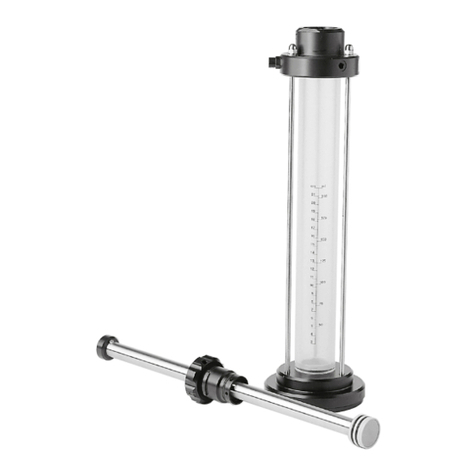
cytiva
cytiva FineLINE Pilot 35 column operating instructions
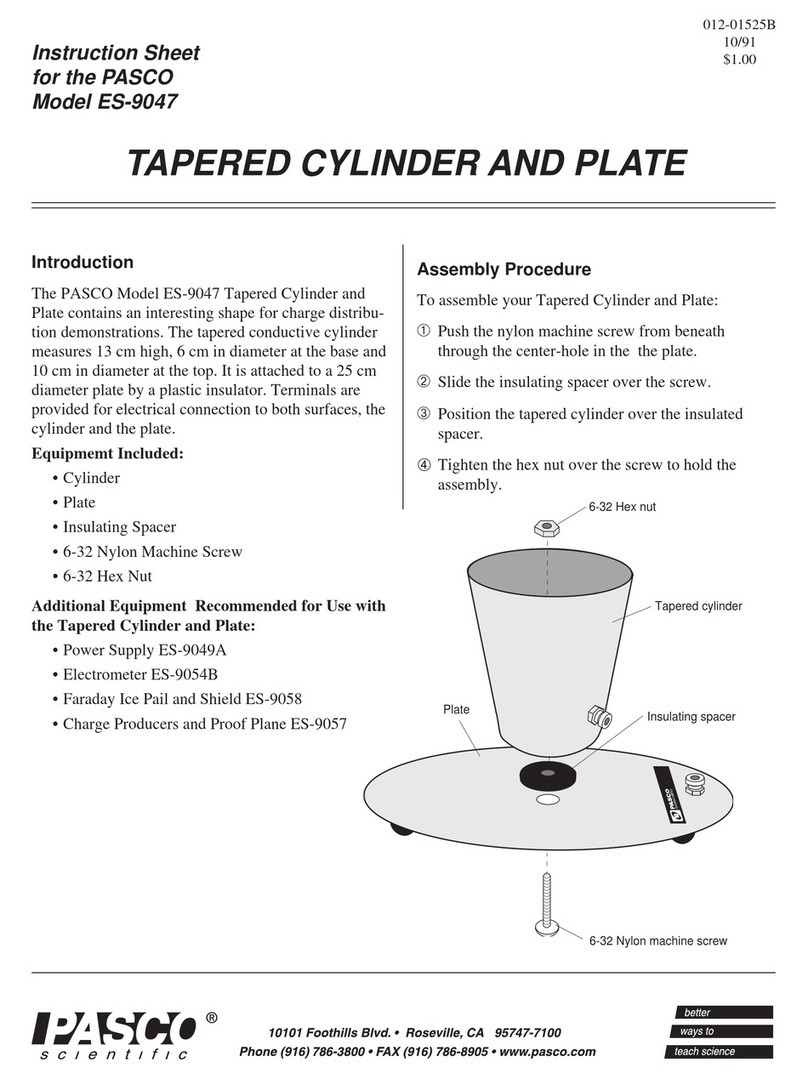
PASCO
PASCO ES-9047 instruction sheet

Thermo Scientific
Thermo Scientific 88881-003 user manual
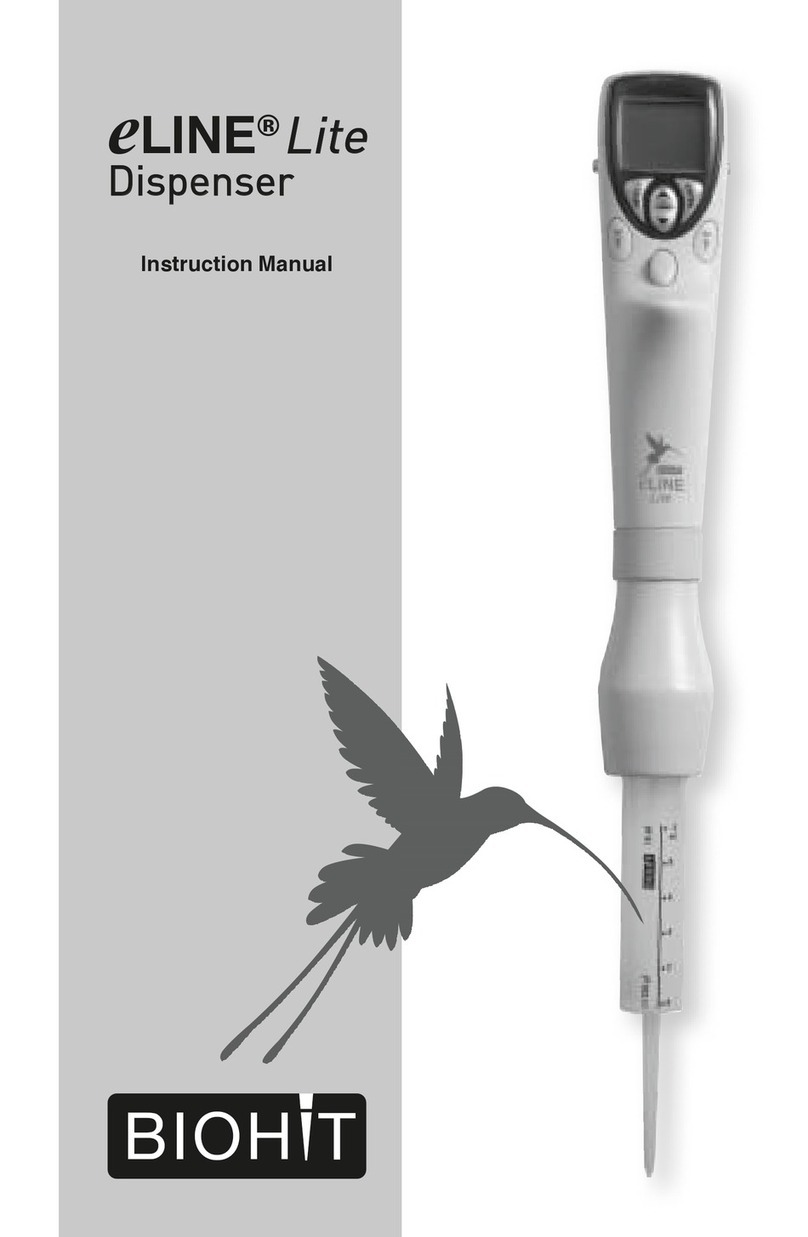
Biohit
Biohit eLINE Lite instruction manual

Thermo Scientific
Thermo Scientific A 40B manual
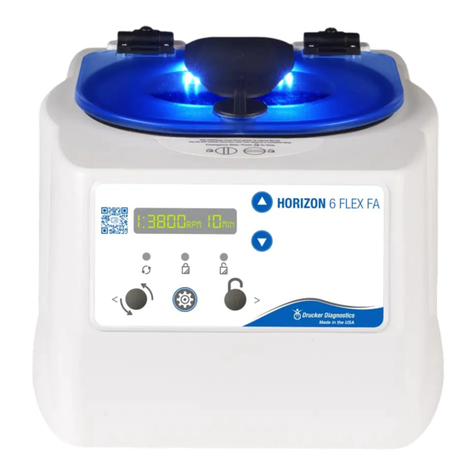
Drucker Diagnostics
Drucker Diagnostics Horizon 6 Flex Operator's manual


